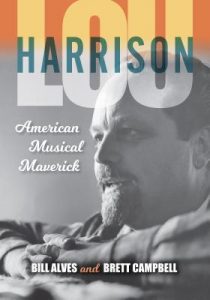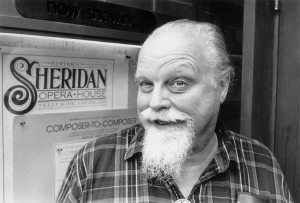 Lou Harrison: American Musical Maverick
Lou Harrison: American Musical Maverick
by Bill Alves and Brett Campbell
Indiana. 602 pages, $55.
THE CENTENNIAL of American composer Lou Harrison’s birth was marked this year by celebrations around the country, including a concert—“Lou 100: In Honor of the Divine Mr. Harrison”—at Tanglewood.
“Divine” is only one of many epithets accorded to, or lobbed against, the composer over his long and prolific life. For those who admire Harrison’s music, he was a guru of the world music movement. He once said that his goal was “to regain … techniques which in the Occident have been destroyed.” For many young American composers in the final decades of the 20th century, this “mirthful Buddha figure” gave them permission “to unabashedly embrace beauty.” But Harrison also has his detractors. Early critics called his music “unfittingly barbarous and noisy.” Later, his embrace of non-Western music systems opened him to the charge of being the “Santa Claus of new music.”
In Lou Harrison: American Musical Maverick, Bill Alves and Brett Campbell have written an eminently scholarly, fair-minded, and exhaustive biography of a composer they claim enjoyed “one of the richest lives ever lived in American arts.” Harrison’s blend of Eastern and Western music-making techniques, his “ecumenical spirituality,” and his deep distrust of the academy allowed him to chart his own path, “without obligation to musical trend makers or others’ ideas of a conventional career.”
Born in Portland, Oregon, in 1917, Harrison enjoyed an idyllic childhood full of art, books, and nature. Musically precocious, he wrote his first composition when he was ten. By the time he was in high school in suburban California, he had immersed himself in every aspect of music. His esoteric interests and shy nature triggered the taunts of classmates, who called him a sissy. The winter after he graduated from high school, Harrison’s family moved to San Francisco, where he discovered the city’s vibrant artistic community, as well as its gay underground. The lonely adolescent “emerged a breathlessly energetic, charming young artist now surrounded by convivial and sympathetic friends.”

Among those early friends was Henry Cowell, an ultra-modernist composer, who became Harrison’s mentor and teacher. Cowell introduced the young Harrison to tone clusters, alternate tunings, polyrhythms, the twelve-tone world of Arnold Schoenberg, and, perhaps most importantly, to the notion that Eastern musical traditions were no less advanced than European forms. By his early twenties, Harrison was “leavening the possibilities” offered by these musical models with his own emerging voice.
In 1938, Harrison met John Cage. While Harrison “cared more about having fun and creating beauty than about Cage’s self-conscious avant-gardism,” the two hit it off. Under Cage’s inspiration, he composed his Fifth Simfony (1939) for four percussionists, a piece he described as “quite Cubistic.” Some critics savaged the piece; others admired his use of non-European musical systems. During the early 1940s, Harrison was in Los Angeles, taking lessons with Schoenberg, who praised the pieces he was working on. Schoenberg encouraged the twelve-tone novice to simplify, pointing him “away from elaboration and complexity and toward the clarity and transparency of Mozart.”
In 1943, Harrison moved to New York. With neither a boyfriend nor much money, and hating the clangor of the city, this was a turbulent and depressing time for him. Much of the music he produced in the next few years was melancholy and sorrowful—“a shadowy soundtrack to disturbing feelings and brushes with madness.” Fortunately, Harrison befriended yet another composer, Virgil Thomson, who hired him as his copyist. Thomson introduced Harrison to a circle of gay and bisexual composers—his “little friends”—among them David Diamond, Leonard Bernstein, Ned Rorem, Paul Bowles, Samuel Barber, and Gian Carlo Menotti.
During these years, Harrison was smoking and drinking heavily. A week before his thirtieth birthday—broke, struggling to compose, rarely getting his music played, and having gone through a painful separation from a lover—he suffered a nervous breakdown and was committed to a psychiatric hospital. It took him a long time, as he put it, “to reconstruct a life out of the detritus,” which led him to a new musical path, one that the authors describe as full of “sunny calm” and “guileless purity.”
Harrison began “to draw from world resources, collecting them like a magpie.” These resources, an eclectic mix of “pan-Pacific sounds,” encompassed Javanese, Indian, Japanese, Thai, Korean, and Chinese musical styles and systems. By the mid 1950s, he had dedicated his life to “integrating two great streams of human music, East and West.” This was also the period when Senator Joe McCarthy was conducting his witch hunts. Some of Harrison’s musical friends, among them Aaron Copland, were targeted. The relentless interrogations made Harrison regret that he had lived a closeted life, and he resolved “never to hide in any closet about anything ever again in my life.”
Increasingly, Harrison’s large-scale compositions—pieces like Pacifika Rondo (1963), a “symbolic tour of Pacific cultures,” and Novo Ordo (1968), a protest oratorio for chorus and orchestra—established themselves as landmarks in the world music movement. Critics and musicians praised the crystalline texture of these works. “One could see Himalayas and skies and forests,” poet Calvin Harlan noted. Musician Robert Hughes called Harrison’s compositions “play, like dolphins in the water.”
In 1967, Harrison met Bill Colvig, who would become his romantic and creative partner for the rest of his life. When Colvig suggested that he write an opera on a gay subject, Harrison enthusiastically turned to the life of the young Julius Caesar. Completed in the early 1970s, at the height of the Vietnam War, Young Caesar featured positive portrayals of homosexuality and intercultural understanding. Unfortunately, its weak libretto and the “sheer audacity” of its world-music texture and gay-rights theme doomed it to failure. Harrison was crushed, but he made a comeback with a Buddhist-inspired piece, La Koro Sutro (1971), which the authors call “one of the greatest sacred works of the twentieth century.”
By his sixtieth birthday, Harrison had become “one of the elder statesmen of American music.” It was around this time that he began writing for the Javanese gamelan orchestra, a sound that had captivated him as far back as 1939, when he first heard Balinese music at the Golden Gate International Exposition. “The actual sound of the gamelan is more appealing to me than that of a symphony orchestra,” Harrison said. Here was music that allowed him to exploit what he was most interested in: melody and rhythm.
In the next few years, Harrison produced an “orgy of gamelan writing,” including his Double Concerto for Violin, Cello, and Javanese Gamelan (1982), one of his masterworks. Such pieces, conceived against the prevailing Western musical institutions, represented an entirely new musical genre. Increasing success brought him commissions, grants, travel opportunities, invitations, and piles of correspondence.
The frenzy of activity took its toll. Harrison began to suffer from exhaustion and poor health, and in 1989 underwent triple bypass surgery. The deaths of several gay composer friends—Aaron Copland, John Cage, and Leonard Bernstein—also took their emotional toll, as did the death of Colvig in 2000. None of these setbacks stopped Harrison, now in his eighties, from pursuing one of the busiest decades of his musical life. He also undertook another relationship, this time with a 44-year old puppeteer, while also enthusiastically pursuing other, more casual sexual encounters. “Unless you have plenty of love, plenty of sex, plenty of affection,” he once said, “it just gets in your way if you’re trying to do creative work.”
On February 2, 2003, while on a trip to Ohio to attend a festival of his music, Harrison collapsed and died. At his memorial service he was remembered for his “joyous energy, ferocious appetite for knowledge, generous philosophy, and contagious ardor for art, science, history, life.” Alves and Campbell have written a noteworthy book, one that combines an engaging biography with valuable musical analysis. The lay reader may find the analysis tough going, but these paragraphs can be skipped over, as I sometimes did, opting instead to listen to the pieces under consideration via YouTube, where a surprising amount of Harrison’s music can be found.
Philip Gambone is the author of four books, including the novel Beijing (Wisconsin).





